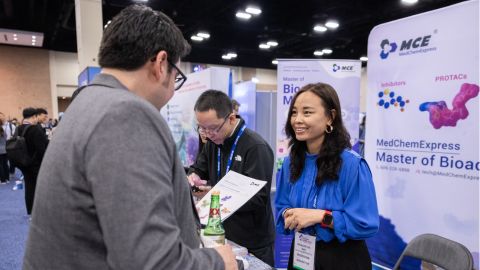The evolution of proteins from mysteries to medicines
What does the word “protein” make you think of? Steak and eggs, or a health food diet, perhaps? What about a cancer drug? Today, advanced medicines are often a purified protein rather than something synthesized by a chemist.
Proteins, built within our cells from individual amino acids, are an intricate class of biomolecules that fulfill a wide array of functions in human biology. That is why a healthy diet includes a constant stream of protein: to fuel the maintenance of our trillions of internal biomolecule machines.
Their core role in our biology is also why protein dysfunction leads to many human diseases. Fortunately, over the last 50 years, scientists have uncovered how to use proteins themselves as drugs to treat the diseases they cause.
It didn’t start fancy, though.

In the late 1800s, doctors researching diabetes narrowed down the problem to the pancreas. In the 1920s, Frederick Banting, Charles Best and J.J.R. Macleod discovered that reinjecting patients with pancreas extracts containing the protein insulin restored blood glucose regulation. They won the 1923 Nobel Prize for their experiments, and the first protein drug was born.
But extracting insulin from animal pancreases for therapeutic use was difficult and inconsistent, and it would take researchers decades to learn how to produce human insulin for use as a medicine.
First, basic molecular biology research uncovered the structure of DNA and how DNA is translated into protein molecules. These and other advances led to the invention of recombinant protein technologies: methods to insert the code for any protein into DNA that can be read by bacteria and other lab-friendly microorganisms. For the first time, our own molecules could be synthesized at large enough scale to be explored as therapeutics.
You might think that what followed was an explosion in the use of proteins as medicines. However, biologics (as they are now called) are challenging molecules to develop and administer to patients. They often suffer from stability or solubility problems, and countless small variations are often tested to find an acceptable therapeutic profile.
For example, the first versions of human insulin degraded so quickly that injections were required many times per day. Optimization took decades and continues today with the growing interest in automated insulin delivery systems.
One important class of biologics are antibodies. Antibodies are an essential part of the mammalian immune system, so when robust antibody production methods were invented in the 1970s, intensive research ensued. The result was the first approval of an antibody drug by the Food and Drug Administration in 1986: muromonab-CD3 to treat the rejection of kidney transplants. Other similar treatments soon followed.
However, these first-generation antibody therapies often induced immune reactions in patients because the hybridoma method used for their production takes advantage of a mouse antibody scaffold. Using human hybridomas was untenable, so researchers developed methods to graft human and animal scaffolds together in chimeras that reduced the immunogenicity of the resulting antibody molecule, all without compromising the portion that attacks the drug target.
The resulting “humanized” antibodies now represent the most profitable and rapidly growing class of approved drugs in the United States.
Since the turn of the century, advances in protein-based medicines have continued. The push to sequence the entirety of the human genome led to large advances in DNA sequencing technology, which in turn enabled new ways to discover proteins for use as drugs.
DNA-encoded libraries can now screen vast (>10^10) protein variants, enabling the rapid discovery of antibodies or peptides with high affinity for drug targets. Paired with decades of production and humanization method development, the pipeline for turning an antibody into a drug candidate is faster than ever before.
The frontiers of biologic drug development now lie in new ways to engineer and modify proteins themselves. For example, antibodies can be made bispecific or have drug payloads conjugated directly to them. Small proteins and peptides can incorporate non-natural amino acids and succeed where larger biologics fail — some are now being tested in clinical trials.
Over the past 50 years, basic research discoveries have transformed proteins from mysterious biological machines to molecules we can use to treat disease. I firmly believe the next 50 years will bring breakthroughs of similar importance. As technological developments enable new ways to discover drugs, the effectiveness of the treatments we can develop will continue apace.
Enjoy reading ASBMB Today?
Become a member to receive the print edition four times a year and the digital edition monthly.
Learn moreGet the latest from ASBMB Today
Enter your email address, and we’ll send you a weekly email with recent articles, interviews and more.
Latest in Opinions
Opinions highlights or most popular articles

Embrace your neurodivergence and flourish in college
This guide offers practical advice on setting yourself up for success — learn how to leverage campus resources, work with professors and embrace your strengths.

Survival tools for a neurodivergent brain in academia
Working in academia is hard, and being neurodivergent makes it harder. Here are a few tools that may help, from a Ph.D. student with ADHD.

Hidden strengths of an autistic scientist
Navigating the world of scientific research as an autistic scientist comes with unique challenges —microaggressions, communication hurdles and the constant pressure to conform to social norms, postbaccalaureate student Taylor Stolberg writes.

Black excellence in biotech: Shaping the future of an industry
This Black History Month, we highlight the impact of DEI initiatives, trailblazing scientists and industry leaders working to create a more inclusive and scientific community. Discover how you can be part of the movement.

Attend ASBMB’s career and education fair
Attending the ASBMB career and education fair is a great way to explore new opportunities, make valuable connections and gain insights into potential career paths.

Benefits of attending a large scientific conference
Researchers have a lot of choices when it comes to conferences and symposia. A large conference like the ASBMB Annual Meeting offers myriad opportunities, such as poster sessions, top research talks, social events, workshops, vendor booths and more.

